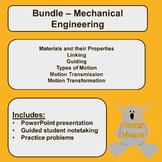1,376 results
Chemistry graphic organizer pdfs

Heat Transfer Thermal Energy Doodle Notes Conduction Convection Radiation
These scaffolded Heat Transfer Cornell Doodle Notes can be used to introduce or review the concepts of temperature, heat, and the types of heat transfer: conduction, convection, and radiation. The notes begin by defining temperature and heat to make clear that temperature is a measure of the average kinetic energy of an object or substance while heat is the flow of energy from hotter to cooler places. The notes define and give real-life examples of conduction, conductors, insulators, convection
Subjects:
Grades:
7th - 9th
NGSS:
MS-PS3-4
, MS-PS1-4
, MS-PS3-3
Also included in: Physical Science Notes Doodle Notes Middle School Science Cornell Notes
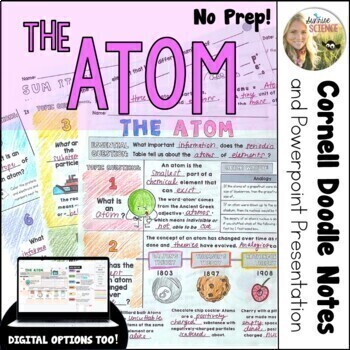
Atoms Notes | Atom Doodle Notes Atomic Theory Protons Electrons | Cornell Notes
These scaffolded, no-prep Atoms Cornell Doodle Notes are an introduction to atoms, subatomic particles, basic atomic structure, and reading the Periodic Table. They combine two effective note-taking strategies: Cornell Notes and Doodle Notes! These notes cover the general definition of an atom, depict a very simplified version of the history of the atomic theory, differentiate the subatomic particles proton, neutron and electron, by their charges, masses, and locations within the atom, explain w
Subjects:
Grades:
7th - 9th
NGSS:
HS-PS1-1
, MS-PS1-1
Also included in: Physical Science Notes Doodle Notes Middle School Science Cornell Notes
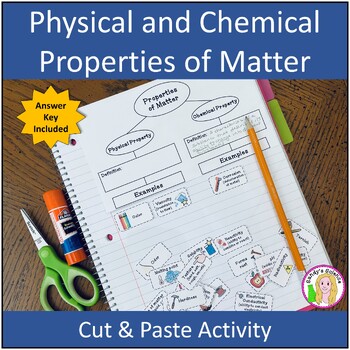
Physical and Chemical Properties of Matter (cut & paste) Activity
Help students clarify the difference between physical and chemical properties with this engaging and hands on sorting activity.Students differentiate between physical and chemical properties by cutting out and sorting terms such as color, density, oxidation, solubility and more. Critical thinking questions included.Add an extra challenge by asking student to identify characteristic properties.Use this activity in an interactive notebook or as a formative assessment / Exit Ticket.An Easel by TPT
Subjects:
Grades:
5th - 8th
Also included in: Science Interactive Notebook - Matter Unit
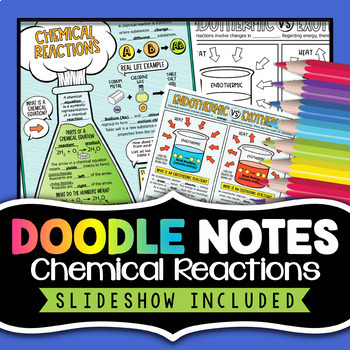
Chemical Reactions Doodle Notes | Endothermic and Exothermic Reactions
This resource is a two-page visual notes sheet that will teach students the basics of chemical reactions. Emphasis is on helping students understand that during a chemical reaction the atoms that make up the original substances are regrouped into different molecules, and these new substances have different properties from those of the reactants (NGSS MS PS1.B). This resource also includes a second page that describes the characteristics of endothermic and exothermic reactions.Included:2 Page Gui
Subjects:
Grades:
7th - 9th
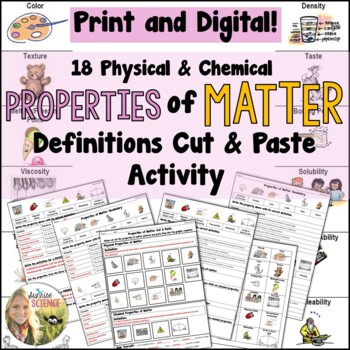
Physical and Chemical Properties of Matter Activity Distance Learning
For this Physical and Chemical Properties of Matter Cut and Paste activity, students match 18 pictures representing the properties of matter with their respective definitions (this is in three groups of six so that it's not too overwhelming). Then, they write the definitions for a physical and chemical property and sort the properties into the category that they believe they each belong.Once the students have made their guesses, have the students cut out the property pictures and lead a class di
Subjects:
Grades:
6th - 8th
NGSS:
MS-PS1-2
Also included in: Properties of Matter and States of Matter | Middle School Science Unit
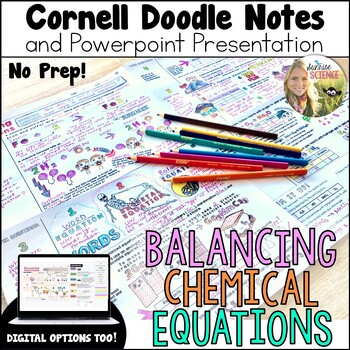
Balancing Chemical Equations Doodle Notes | Middle School Science | Cornell Note
These scaffolded Balancing Chemical Equations Cornell Doodle Notes combine two effective note-taking strategies and can be used to introduce, teach, or review the concept of balancing chemical equations and the Law of Conservation of Mass. These notes review chemical formulas including coefficients and subscripts, differentiate between word, skeletal, and balanced equations, use two non-chemistry analogies to help students visualize what a balanced equation means, give steps for balancing an equ
Subjects:
Grades:
7th - 9th
NGSS:
HS-PS1-7
, MS-PS1-5
Also included in: Physical Science Notes Doodle Notes Middle School Science Cornell Notes

Elements Compounds Mixtures Doodle Notes | Middle School Science | Cornell Notes
These scaffolded Elements, Compounds, and Mixtures Cornell Doodle Notes can be used to introduce the concept of classifying matter. The concepts of diatomic elements, homogeneous mixtures or solutions, and heterogeneous mixtures including suspensions and colloids are included. The notes use lots of visuals and real-life examples to help students understand the concept of classifying matter, as well as “Do” exercises that help students to interact with the information in the notes. These notes su
Subjects:
Grades:
7th - 8th
NGSS:
MS-PS1-1
Also included in: Physical Science Notes Doodle Notes Middle School Science Cornell Notes
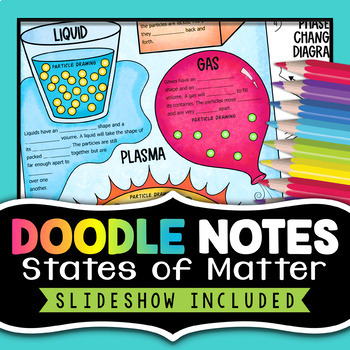
States of Matter Doodle Notes - Solid, Liquid, Gas, Plasma, Phase Changes
This resource is a two-page doodle notes sheet that focuses on states of matter. Students will learn about the properties of solids, liquids, gases, and plasma, phases of matter, and phase changes as they complete embedded doodle tasks. Included:2 Page Guided Doodle Notes — Fill-in-the-BlankThis version offers the most structure for students.2 Page Blank Doodle Notes — Blank Graphic OrganizerThis blank template is ideal for teachers who prefer less structure.Teacher Key — Low Ink and Fully Color
Subjects:
Grades:
5th - 8th
Also included in: States of Matter Activity Bundle - Doodle Notes, Lab, Project, and More!
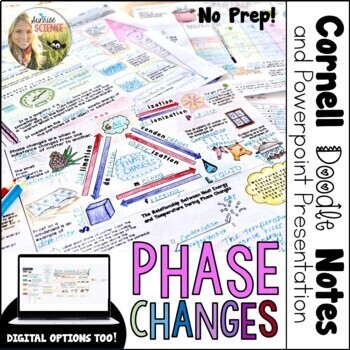
Phase Changes Doodle Notes | Middle School Science | Cornell Notes
These scaffolded Phase Changes Cornell Doodle Notes can be used to introduce or review the states of matter, and to teach about thermal energy, particle motion, the state of substances due to kinetic energy, and the phase changes between solids, liquids, gases, and plasmas. The notes use lots of visuals to help students understand the relationship between energy and matter. The concepts align with the Disciplinary Core Ideas of NGSS Standard MS-PS1-4.Cornell Notes are a note-taking strategy in w
Subjects:
Grades:
7th - 9th
NGSS:
MS-PS1-4
Also included in: Physical Science Notes Doodle Notes Middle School Science Cornell Notes
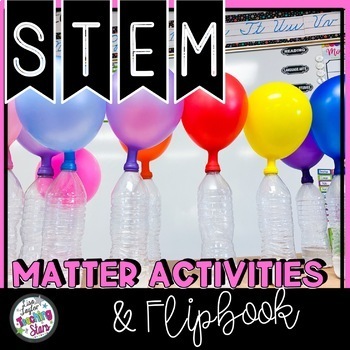
States of Matter STEM Activities and Experiments
Teaching Matter and how matter changes? ⭐️Are you looking for experiments and science labs to get your students excited about matter and supplement your curriculum? Look no farther! Matter STEM Activities will be a great supplement for any matter unit. Students will make observations and measurements to identify different physical properties of matter. Students conduct investigations as they learn about chemical and physical changes. Students will make observations and record data while co
Subjects:
Grades:
4th - 6th
NGSS:
5-PS1-3
, 5-PS1-4
, 5-PS1-2
, 5-PS1-1
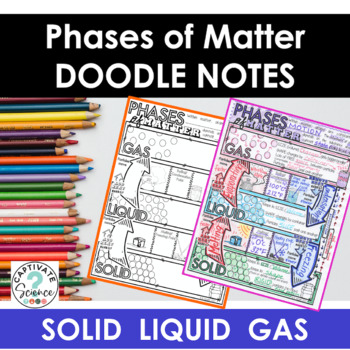
States (Phases) of Matter Doodle Notes | Science Doodle Notes
States (Phases) of Matter “Doodle Notes”** 2020 Update- Purchase the digital update version HERE if you are in need of digital tools to support your doodle notes instruction! **These doodle notes are a visual learning tool for helping your students understand particle traits of SOLIDS, LIQUIDS and GASES. Ideal for middle school or upper elementary science, doodle notes help provide visual triggers that improve focus, memory and learning. It is amazing how students interact with the content thr
Subjects:
Grades:
5th - 6th
Also included in: Physical Science Bundle: Lessons, Games, Doodle Notes and MORE!
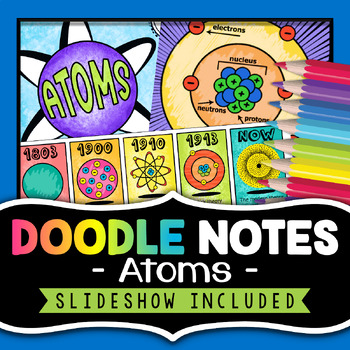
Atoms Doodle Notes - Atomic Structure - Science Interactive Notebooks
This resource is a two-page doodle notes sheet that focuses on atoms. Students will learn concepts such as the history and structure of atoms as they complete embedded doodle tasks. Included:2 Page Guided Doodle Notes — Fill-in-the-BlankThis version offers the most structure for students.2 Page Blank Doodle Notes — Blank Graphic OrganizerThis blank template is ideal for teachers who prefer less structure.Teacher Key — Low Ink and Fully ColoredGoogle™ Slideshow that aligns with the Guided Fill-in
Subjects:
Grades:
6th - 9th
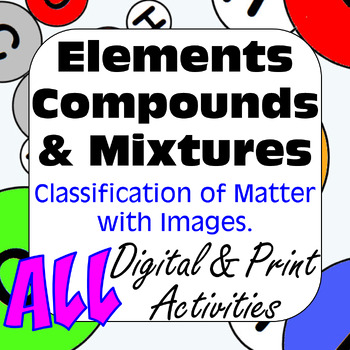
Elements Compounds & Mixtures Classification of Matter with Images & Organizer
Ready to zoom down to the molecular level and get your hands dirty with elements, compounds, and mixtures? Strap on your lab goggles, because we've got two essential tools to kick-start your journey into the classification of matter!First up, a Flowchart Style Graphic Organizer will have you visualizing the differences in no time. It's like a secret decoder ring for the molecular realm! And once you've got the basics down, test your skills with the Interactive Digital Adaptations. These self-che
Subjects:
Grades:
5th - 10th
CCSS:
NGSS:
MS-PS1-1
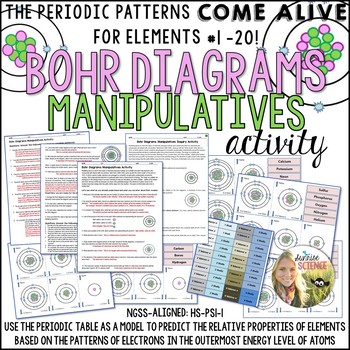
Bohr Diagram Atom Manipulatives Activity
When students construct the periodic table in this Bohr Diagrams Atom Manipulatives activity, they will see the patterns that exist in the table without you saying anything. These cards depict Bohr Diagrams for elements #1-20 of the periodic table. This activity is great to use once your students understand that the “identity” of an atom can be determined by its number of protons, and that in a neutral atom the protons equal the electrons. It also aligns nicely with NGSS Standard HS-PS1-1 (Use t
Subjects:
Grades:
7th - 9th

Chemistry Doodle Notes for the Year: A Growing Bundle
This growing bundle will eventually contain doodle notes for each chemistry unit in the year curriculum! Buy now while the price is low! Your students will create doodle notes that they will be proud of and use! Each doodle note file includes teacher notes with suggestions for many ways of incorporating doodle notes in your class, and includes an example suggestion for completing the doodle notes. For interactive notebooks—just print at 90%, and it will fit beautifully!The notes have some blank
Subjects:
Grades:
9th - 12th
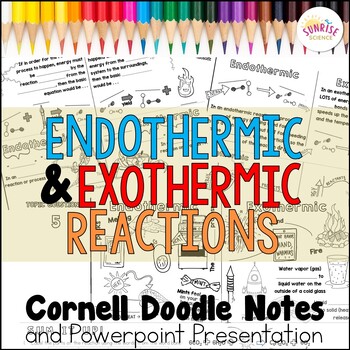
Endothermic and Exothermic Reactions Doodle Notes | Middle School Science
These no-prep, scaffolded Endothermic and Exothermic Reactions Cornell Doodle Notes combine two effective note-taking strategies and can be used as part of the input for NGSS Standards MS-PS1-6 (Chemical Reactions: Some chemical reactions release energy, others store energy.), HS-PS1-4-5 (Chemical processes, their rates, and whether or not energy is stored or released can be understood in terms of the collisions of molecules and the rearrangements of atoms into new molecules.) to teach about how
Subjects:
Grades:
7th - 9th
NGSS:
HS-PS1-4
, MS-PS1-6
Also included in: Physical Science Notes Doodle Notes Middle School Science Cornell Notes

Experimental Design Doodle Notes - Scientific Method Vocabulary - Variables
This resource is a two-page doodle notes sheet regarding Experimental Design. This doodle note best aligns with the NGSS Science and Engineering Practice of Planning and Carrying Out Investigations. The vocabulary includes observation, asking scientific questions, hypothesis, science variables, independent variable, dependent variable, controlled variable, experimental and control groups, data, and writing a conclusion. Included:2 Page Guided Doodle Notes— Fill-in-the-Blank (with an example exp
Subjects:
Grades:
6th - 8th
Also included in: Experimental Design Activity Bundle

Chemical Reactions Doodle Notes | Middle School Science | Cornell Notes
These scaffolded Chemical Reactions Cornell Doodle Notes combine two effective note-taking strategies and can be used to introduce the indications of chemical reactions (color and change, gas production, precipitate formation, and energy emission) and the 5 main types of reactions (synthesis, decomposition, single and double replacement, and combustion). These notes use lots of visuals and analogies to help students to understand how atoms are rearranged during chemical reactions and that reacti
Subjects:
Grades:
7th - 9th
NGSS:
MS-PS1-5
, HS-PS1-2
Also included in: Physical Science Notes Doodle Notes Middle School Science Cornell Notes

Bohr Diagrams of Atoms Doodle Notes | Middle School Science | Cornell Notes
These scaffolded Cornell Doodle Notes combine two effective note-taking strategies and can be used to introduce the concepts of Bohr Diagrams to model atoms. These notes support NGSS HS-PS1-1 (Use the periodic table as a model to predict the relative properties of elements based on the patterns of electrons in the outermost energy level of atoms.) They cover the concept of using a model in science and how a Bohr Diagram is a representation of an atom. Then they introduce the Bohr model, explain
Subjects:
Grades:
7th - 9th
NGSS:
HS-PS1-1
, MS-PS1-1
Also included in: Physical Science Notes Doodle Notes Middle School Science Cornell Notes
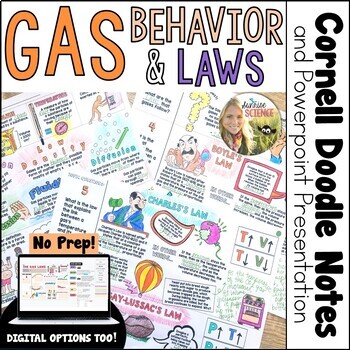
Gas Laws Notes | Doodle Notes | Boyle's Law | Charles's Law | Cornell Notes
These scaffolded Gas Laws Cornell Doodle Notes combine two effective note-taking strategies and can be used to introduce or review the behavior of gases and the gas laws. These notes seek to explain Boyle’s, Charles’s, and Gay-Lussac’s gas laws in a conceptual way and they do not include the formulas or any calculations for them. The notes use visuals and real-life examples to help students understand the relationship between temperature, volume, and pressure of gases. These concepts align with
Subjects:
Grades:
8th - 9th
NGSS:
MS-PS1-4
Also included in: Physical Science Notes Doodle Notes Middle School Science Cornell Notes
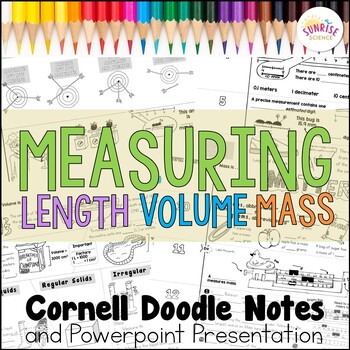
Measuring Length Volume Mass Doodle Notes | Middle School Science
Teach about measuring length, volume, and mass with precision and accuracy with these Measuring Cornell Doodle Notes! These notes are a great way to introduce your students to the concepts of precision and accuracy, measuring length, volume (of solids, liquids, rectangular-shaped, and irregularly-shaped objects), and measuring mass with a triple beam balance. These notes cover the metric units and tools for each type of measurement. There is a ‘Sum It Up’ page that has practice exercises to help
Subjects:
Grades:
7th - 9th

Periodic Table Doodle Notes | Metals Nonmetals | Groups Periods | Cornell Notes
These scaffolded, no-prep Periodic Table Basics Cornell Doodle Notes are an introduction to the basic layout and parts of The Periodic Table as part of a study of basic chemistry and atoms! These notes cover Mendeleev and the early Periodic Table, the concept of periodicity, how the modern Periodic Table is arranged, periods and groups, metals, nonmetals, and metalloids and their properties, and the names and locations of the element families including the Alkali Metals, Alkaline Earth Metals, T
Subjects:
Grades:
7th - 9th
NGSS:
HS-PS1-1
Also included in: Physical Science Notes Doodle Notes Middle School Science Cornell Notes

Metals, Nonmetals, Metalloids (cut & paste) Activity
Students practice classifying the properties and examples of metals, nonmetals and metalloids with this sorting activity.Use this activity in an interactive notebook or as a formative assessment / Exit Ticket.Print OptionsStandard - students cut, sort and paste on a graphic organizer then answer follow-up/summary questions. Differentiated - 2 different notebook outlines included (just headings, headings and boxes where to paste tiles)2 options for cut & paste tiles (full sheet & paper sa
Subjects:
Grades:
5th - 9th
Also included in: Science Interactive Notebook - Matter Unit
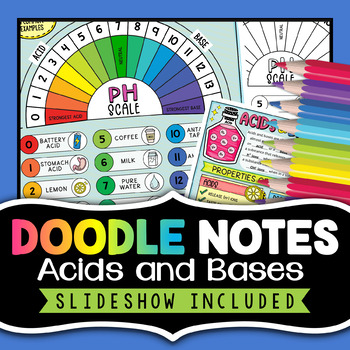
Acids and Bases + pH Scale Doodle Notes Activity | Acids Bases Worksheet
Engaging Two-page Acids and Bases V I S U A L Doodle Notes ActivityConcepts Covered:Page one of the visual notes discusses the properties of acids and bases and page two explains the pH scale. I have also included an additional (and optional) 3rd-page Checking for Understanding worksheet.Why Doodle Notes?Doodle notes are a form of visual note-taking that embeds brain-based research elements such as dual-coding theory. Dual coding theory emphasizes the use of mental images to aid learning. I incl
Subjects:
Grades:
6th - 9th
Showing 1-24 of 1,376 results


